Great Reset
A One-Stop Shop for Illegal Migration Reveals Ongoing Plans for Illegal Immigration

From the Center for Immigration Studies
By Todd Bensman
UN/NGO ‘mall’ under construction in southern Mexico shows they expect continued illegal flow to the U.S.
A 75,000-square-foot mega-mall, built to enable industrial-scale illegal immigration to the U.S. southern border, is almost online here in this key entry city in southern Mexico just across the border from Guatemala.
Scheduled to open in December, the mall suggests that powerful global agencies, the United Nations key among them, are bullish on a long-term future of continued heavy U.S.-bound illegal migrant traffic through Mexico – no matter the outcome of the November 5 American presidential election.
Those bullish investors are the dozens of migration-oriented UN agencies and non-governmental organizations (NGOs) that have already plowed hundreds of millions of dollars of U.S. taxpayer money into constructing a permanent network of way stations for thousands of miles along the migration routes from South America to the U.S. border during the four years of the Biden-Harris administration.

A Nicaraguan on his way to the U.S. showed his UN cash card in Monterrey, Mexico. January 2023 photo by Todd Bensman.
The record hundreds of millions of dollars in aid is distributed at the way station network in the form of cash cards, cash in envelopes, food, vouchers for onward travel and lodging, medical treatment, pharmaceuticals, legal counseling, and much more. (See: “UN Budgets Millions for U.S.-Bound Migrants in 2024”.) This aid has without doubt helped the UN and its growing constellation of NGOs keep the masses moving north through Tapachula in record numbers toward irresistible Biden border policies that have welcomed across arrivals in historic millions. (See: “Biden Admin. Sends Millions to Religious Nonprofits Facilitating Mass Illegal Migration”.)
The UN and NGOs are betting on a busy future in Mexico. Going forward, the purpose of this one strategically located facility is to “respond comprehensively to the needs of people who arrive in Mexico … migrant refugees who travel together from all continents, and arrive in Tapachula in need of a response or attention”, Giovanni Lepri, the Mexico representative for the United Nations High Commission on Refugees (UNHCR), told reporters when Mexico’s foreign ministry announced it in April 2024.
But the Tapachula mall represents a far more expansive billion-dollar migration-route safety net constructed during the Biden-Harris years using record-breaking U.S. taxpayer contributions.
It plugs into two other big one-stop-migration malls erected in the northern Mexico cities of Monterrey and Tijuana. These gleaming new Mexican facilities, and plenty of other UN and NGO substations in Mexican towns and cities, form the final terminus of the trails to the United States lined with pots of U.S. taxpayer money. And they are representative of what’s happening throughout Latin America.
The UN High Commissioner for Refugees (UNHCR), which received $1.9 billion in U.S. taxpayer funds in 2024 and $2.1 billion in 2023 (compared to $377 million in 2019) for migration assistance throughout Latin America, started building the Tapachula facility on land donated by Chiapas State as part of the deal with Mexico to run it.
The UNHCR, UN’s International Organization for Migration (IOM), UNICEF, and dozens of private, often religion-based, NGOs scattered around Tapachula will work alongside one another under one massive roof here — evidently planning a years-long collaboration.
None of the UN/NGO pots of gold are exactly a secret but are relatively hard to find for the uninitiated. And harder to grasp as connected to domestic American policies or as a legitimate point of political debate.
The UN’s 2024 update to the “Regional Refugee and Migrant Response Plan” (RMRP for short), a UNHCR and IOM planning and budget document, lays out in detail that it planned to hand out nearly $1.6 billion in 17 Latin America countries using its network of 248 different NGOs. (For the complete list of involved groups, see p. 268, here, and explore their activities further with this interactive tool).
That was on top of the 2023-2024 RMRP plan, which called for 228 NGOs (all listed on p. 268 of the list of involved groups) to spend $1.72 billion on trailside assistance to mass migration that all know will illegally pass through many countries and, finally, breach the U.S. border.
Hundreds of millions of dollars for all of this comes straight from U.S. taxpayers in the form of sharply increased US State Department bequeathals, USAID grants, and flexible spending contributions to the UNHCR and IOM.
Too Far for Average Americans to See

Necocli, Columbia to Acandi, Panama
For an idea of how U.S. tax money is spent to flood the American border, the far northwest Colombian town of Necocli provides a window. This is a major staging town for migrants preparing to boat across the Gulf of Uraba for smuggler-guided backpack trips through the so-called “Darien Gap” jungle passage that leads into Panama and eventually Mexico.
In Necocli, the UN and NGO agencies have arrayed themselves in something like an outdoor swap meet of NGO booths and an IOM mobile bus office on a few acres next to the gulf beach, the Center for Immigration Studies observed during an August 2024 research trip to the region. The Jewish NGO Cadena was set up in a booth next to the Adventist Development and Relief Agency (ADRA).
NGO and UN workers there said they provide a variety of trail advice — and plenty of supplies to the immigrants, to include socks, underwear, backpacks, bug repellant, water filters, sunscreen, and Vaseline.
And food.
“Like things easy to carry so they can eat and be done with it,” a Cadena worker said.
ADRA provides children’s classes thrice weekly on how to avoid sexual predators among the strange men traveling the Darien Gap.
On this day, a Cadena worker said she’d given out thousands of food items such as packaged soup to more than 3,000 migrants during the previous few months, showing the last of it: a box with a handful of granola bars she hoped to hand out soon so she could go home.
What about critics who say NGOs like Cadena are helping migrants break the laws of many countries?

A Cadena NGO worker in Necocli, Colombia. August 2024 photo by Todd Bensman.
“As an organization,” the Cadena worker responded. “We’re not here to judge. We’re just here to provide a service.”
”But aren’t you helping them migrate?”
“Only by giving them the things that I mentioned, not money or fare, just certain resources for the trip,” she explained.
UNHCR workers carrying iPads interacted with groups of migrants sitting in chairs under open-air shelters, surveying them and their needs for the trail ahead. The IOM workers hand out hygiene kits to women, but had run out of the kits some days earlier.
Across the Uraba Gulf in the staging town of Acandi, the Clan del Gulfo paramilitary controls the human smuggling operations into the Darien Gap. The cartel runs two migrant camps where the migrants are brought for final journey preparations.
The center gained permission to access one of the camps, “Camp 1”. Inside, the Center found NGOs providing medical services, legal counseling, and food.
Furthermore, Colombian banks also have been allowed to set up a money-wiring service so that migrants could pay their foot guides.
All involved could not possibly be unaware that the people they are assisting intend to break the immigration laws of a half dozen countries up trail, including, ultimately, illegally breaching the American border.
A Bright Future for Mass Migration?
The UN and NGO’s migration advocacy industrial complex is now preparing its 2025-2026 plan for the trails of Latin America.
A request for input from its NGO partners suggests an ambitious coming year of providing “cash and voucher assistance”, “food security”, “humanitarian transportation”, “shelter”, and most other basic human needs.
Who will be the recipients?
Refugees and migrants in-transit (of all nationalities) who cross an international border.
International
Daughter convinces healthy father to die in double assisted suicide with mother

From LifeSiteNews
By Cassy Cooke
After her parents both became seriously ill and her mother wanted to undergo assisted suicide, a Washington woman convinced her father to die also.
Key takeaways
- Corinne Gregory Sharpe spoke to PEOPLE about her experience convincing her parents to undergo assisted suicide together.
- After her mother was diagnosed with aortic stenosis in her 90s, she lived for a few more years before her health began to decline. At that point, she said she wanted to die by assisted suicide.
- Her father did not have a health condition outside of having previously had a stroke; however, he was nervous to live without his wife. Sharpe convinced him of a “solution” – to kill himself alongside her mother.
- Couple assisted suicide has become romanticized by the media.
The details
Corinne Gregory Sharpe spoke with PEOPLE about her efforts to convince her father to undergo assisted suicide alongside her mother. She said her family had always been close, so when her mother became ill, her father was nervous to live without her.
Sharpe’s mother was first diagnosed with aortic stenosis in 2018 at the age of 92 and given less than two years to live if she did not undergo surgery.
“And even if she had the procedure, there was no guarantee that she was gonna live any longer,” Sharpe said. “So her attitude was sort of like, well, let’s just kind of let things go as they go.”
READ: Colorado gave over 500 people assisted suicide drugs solely for eating disorders in 2024
But Sharpe’s mother didn’t die within those two years. In fact, it was three years later that her health began to decline, only after she fell and hit her head. Shortly after that, Sharpe’s father appeared to suffer small strokes. “So now I have two parents in medical care,” Sharpe said.
Her parents were able to be at a rehabilitation facility together, but Sharpe said they were “losing the will to live,” so she brought them back home. Doctors recommended hospice, but her mother decided she wanted to undergo assisted suicide, which left her father distraught. Sharpe came up with an “interesting” solution.
“I had a very interesting, serious heart-to-heart conversation with him one evening after my mom had gone to bed,” she continued. “And he was just panicked like, ‘What happens to me if she goes first?’ That’s always been a concern of his. He couldn’t see a scenario where he would want to continue if mom was gone.”
She added, “He’s always been afraid of dying. But I think he was more afraid of being left alone. He was like, ‘Well, if she’s gonna go and I have the option to go at the same time, then I’m getting on that horse.’ So I was like, look, we’ll figure something out.”
At this point, her father was not dying, and if he suffered another stroke, doctors believed he could end up incapacitated, but not terminally ill. Yet Sharpe was able to get her father approved for assisted suicide, calling it “a race” to do so.
Sharpe spent what would be the last few weeks of her parents’ lives hosting family dinners, making them their favorite meals, and sharing memories as a way to “repay my parents for everything they’d done for me.” It sounds nice, but there’s no need for an adult child to wait until she knows her parents are dying to do such things for them.
When the drug powder arrived, Sharpe took a selfie with the delivery man and then stuck the drug on a shelf, where it feasibly could have been accessed by anyone. She then joked about choosing Friday the 13th to die, which is when her parents ultimately took the drugs – Friday, August 13, 2021.
“The counselors prepared the cocktail, we sat around and shared some private moments together. They got to sit in their own bed and hold hands with each other and talk before they were able to take the meds,” she said. “We put music on and they took the cocktail. Then we poured a glass of wine and we had a final toast. About 10 minutes after they drank it, they went to sleep.”
Zoom out
It has become increasingly common and romanticized for elderly couples to be euthanized together. This includes murder-suicides and those who opt to die together simply because they are elderly.
But the reality of assisted suicide is that it may not be as peaceful and romantic as many have been led to believe.
As Dr. Joel Zivot, an associate professor of anesthesiology and surgery at the Emory School of Medicine and an expert on “physician participation in lethal injection,” previously explained, assisted suicide can be excruciating, even if it doesn’t appear to be.
“[F]or both euthanasia and executions, paralytic drugs are used,” he wrote in an op-ed for the Spectator. “These drugs, given in high enough doses, mean that a patient cannot move a muscle, cannot express any outward or visible sign of pain. But that doesn’t mean that he or she is free from suffering.”
He added, “People who want to die deserve to know that they may end up drowning, not just falling asleep.”
Furthermore, a study in the medical journal Anaesthesia found that prolonged, painful deaths from assisted suicide and euthanasia were far from rare, with a considerable number of patients taking 30 hours to die, though some took seven days. Experiments with assisted suicide likewise have been painful, with one drug cocktail “burning patients’ mouths and throats, causing some to scream in pain.” The same drugs labeled as too inhumane to be used for lethal injection are used in assisted suicide.
The bottom line
Suicide is not dignified, peaceful, or romantic. Efforts are made to prevent suicide unless the person in question is elderly, ill, or disabled. And then, it’s made to appear noble and romantic to take your own life.
Reprinted with permission from Live Action.
Censorship Industrial Complex
Canada’s privacy commissioner says he was not consulted on bill to ban dissidents from internet

From LifeSiteNews
Privacy Commissioner Philippe Dufresne that there was no consultation on Bill C-8, which is touted by Liberals as a way to stop ‘unprecedented cyber-threats.’
Canada’s Privacy Commissioner admitted that he was never consulted on a recent bill introduced by the Liberal government of Prime Minister Mark Carney that became law and would grant officials the power to ban anyone deemed a dissident from accessing the internet.
Privacy Commissioner Philippe Dufresne said last week that in regard to Bill C-8, titled “An Act respecting cyber security, amending the Telecommunications Act and making consequential amendments to other Acts,” that there was no consultation.
“We are not consulted on specific pieces of legislation before they are tabled,” he told the House of Commons ethics committee, adding, “I don’t want privacy to be an obstacle to transparency.”
Bill C-8, which is now in its second reading in the House of Commons, was introduced in June by Minister of Public Safety Gary Anandasangaree and has a provision in which the federal government could stop “any specified person” from accessing the internet.
All that would be needed is the OK from Minister of Industry Mélanie Joly for an individual to be denied internet service.
The federal government under Carney claims that the bill is a way to stop “unprecedented cyber-threats.”
The bill, as written, claims that the government would need the power to cut someone off from the internet, as it could be “necessary to do so to secure the Canadian telecommunications system against any threat, including that of interference, manipulation, disruption, or degradation.”
While questioning Dufresne, Conservative MP Michael Barrett raised concerns that no warrant would be needed for agents to go after those officials who want to be banned from the internet or phone service.
“Without meaningful limits, bills like C-8 can hand the government secret, warrantless powers over Canadians’ communications,” he told the committee, adding the bill, as written is a “serious setback for privacy,” as well as a “setback for democracy.”
Barrett asked if the goal of the bill is for Parliament to be granted “sweeping powers of surveillance to the government without a formal review?
Dufresne said, “It’s not a legal obligation under the Privacy Act.”
Experts have warned that Bill C-8 is flawed and must be “fixed.”
The Canadian Civil Liberties Association (CCLA) blasted the bill as troublesome, saying it needs to “fix” the “dangerous flaws” in the bill before it becomes law.
“Experts and civil society have warned that the legislation would confer ministerial powers that could be used to deliberately or inadvertently compromise the security of encryption standards within telecommunications networks that people, governments, and businesses across Canada rely upon, every day,” the CCLA wrote in a recent press release.
Canada’s own intelligence commissioner has warned that the bill, if passed as is, would potentially not be constitutionally justified, as it would allow for warrantless seizure of a person’s sensitive information.
Since taking power in 2015, the Liberal government has brought forth many new bills that, in effect, censor internet content as well as go after people’s ability to speak their minds.
Recently, Canadian Conservative Party MP Leslyn Lewis blasted another new Liberal “hate crime” bill, calling it a “dangerous” piece of legislation that she says will open the door for authorities to possibly prosecute Canadians’ speech deemed “hateful.”
She also criticized it for being silent regarding rising “Christian hate.”
-

 City of Red Deer1 day ago
City of Red Deer1 day agoPlan Ahead: Voting May Take a Little Longer This Election Day
-

 Crime21 hours ago
Crime21 hours agoFrance stunned after thieves loot Louvre of Napoleon’s crown jewels
-

 Uncategorized23 hours ago
Uncategorized23 hours agoNew report warns WHO health rules erode Canada’s democracy and Charter rights
-

 Business1 day ago
Business1 day agoUS government buys stakes in two Canadian mining companies
-

 Energy24 hours ago
Energy24 hours agoMinus Forty and the Myth of Easy Energy
-

 Frontier Centre for Public Policy1 day ago
Frontier Centre for Public Policy1 day agoOttawa Should Think Twice Before Taxing Churches
-

 Fraser Institute1 day ago
Fraser Institute1 day agoMétis will now get piece of ever-expanding payout pie
-

 Alberta1 day ago
Alberta1 day agoBusting five myths about the Alberta oil sands


